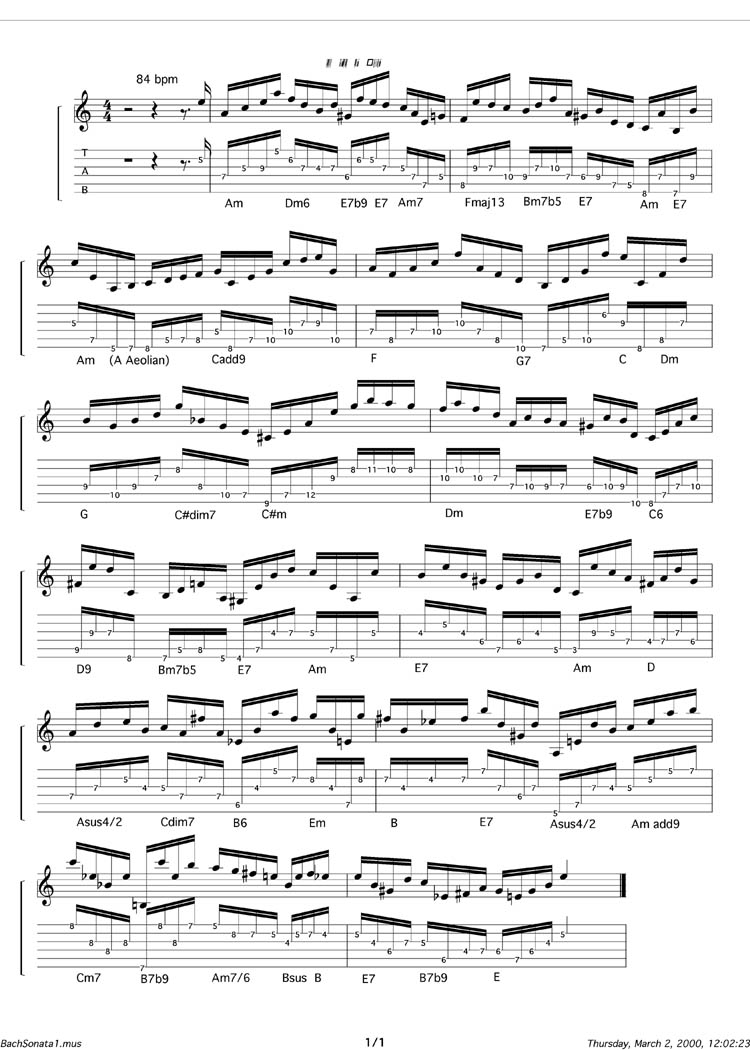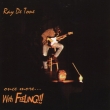This Bach Sonata came my way via a guitar student that had visited Jennifer Batton's web site and discovered her two handed tapping arrangement of this violin piece. Since the tapping was way over his head he started to learn the piece by flatpicking it but soon discovered that finding the appropriate and most efficient fingering was not always as simple as it may appear.
Thus I transcribed the following fingering and turned it into a lesson (or quite a few lessons in the case of this student) which is a great exercise for right hand picking as well as left hand fretting technique. And to keep the student thinking about theory instead of blindly playing patterns over and over again, I had him figure out the appropriate chords that Bach was arpeggiating in this melody.
Start real slow with this figure and take it measure by measure. Work your way up to a tempo of 84 bpm (and beyond if you dare). Keep your picking strictly alternating. (A down-pick always follows an up-pick and an up-pick always follows a down-pick - NO EXCEPTIONS!) To make this exercise a valuable theory lesson you should know the basic chord construction of the following:
| Major chord | 1st, 3rd ,5th intervals of major scale (all C root chords go with the C major scale,etc.) |
| Minor | 1, b3, 5 |
| Seventh | 1, 3 , 5, b7 |
| Minor 7th | 1, b3, 5, b7 |
| Major 7th | 1, 3, 5, 7 |
| Major 6th or 6th | 1, 3, 5 , 6 |
| Minor 6th | 1, b3, 5, 6 |
| Major 13th | 1, 3, 5, 7, 9, 11, 13 ( in this case 1, 3, 7,13) |
| Suspended (sus, sus4) | 1, 4, 5 |
| Suspended 2nd | 1, 2 , 5 |
| m7b5 (half-diminished) | 1, b3, b5, b7 |
| Diminished (dim) | 1, b3, b5 |
| Diminished 7th | 1, b3, b5, bb7(6) |
| 7b9 | 1, 3, 5, b7 ,b9 |
| add9 | 1, 3, 5, 9 |
| Augmented (aug, +) | 1, 3, #5 |
| Augmented 7th | 1, 3, #5, b7 |
Please note that there is more than one way to name a chord (or arpeggio) depending on where you choose the root or tonal center to be. While triads and sevenths may seem obvious , keep in mind that as you extend the harmonization of the major scale further (chords with 4 or more unique notes), add tensions to the chord (b9, #9, #11 etc.) and/or remove some of the intervals (i.e. C7 played in the open position has no 5th ), you will find there will often be at least two different chord names that you could give a group of notes. Notice, in measure 4, I don't try to name an arpeggio when the group of notes is more easily recognized as a natural minor scale. (A Aeolian)
As you play thru each measure of this piece take a mental picture of the notes and patterns of the arpeggios Relate them to each of the chord names I have placed under the group of notes. And remember some of these shapes and arpeggios are not the most obvious but they can definitely be used to solo over the chord mentioned, in any song you play.Thank you , once again , Mr. Bach.

Ray DeTone is a professional guitarist featured in Guitar Player magazine (March 1998). Ray is an eclectic player, fusing the elements of rock, blues, progressive, country, metal, alternative and even bluegrass, creating a signature sound that stands out amidst todays' onslaught of redundancy.
His debut instrumental CD is entitled "Once More...With Feeling!!!".
